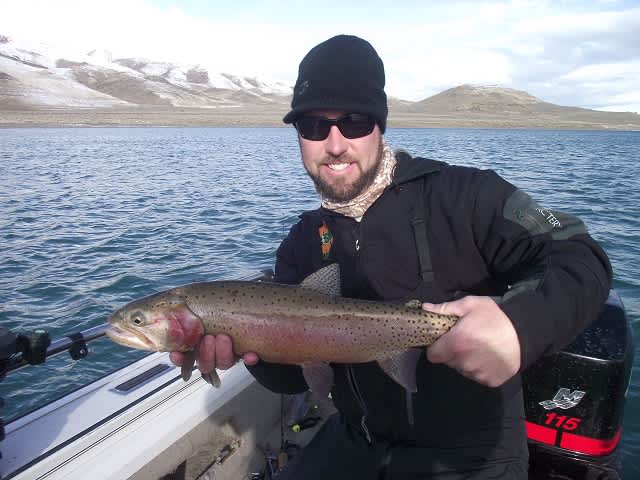Fishing for Low Pressure Cutthroat Trout at Pyramid Lake, Nevada
Wild Fish Wild Places 02.10.12

Last spring the Wild Fish Wild Places filming crew spent a week at Pyramid Lake, Nevada and encountered cold temps, rain, and plenty of wind. Even though the barometer was low and our options were limited due to wind, we felt confident about getting the footage that we needed for the show. After all, this was one of our home waters, where Denis and I have sixty years of combined experience chasing the rare Lahontan cutthroat trout that inhabit Pyramid Lake. Cutthroats are a beautiful game fish but they are the most temperamental fish that I’ve fished for, boasting hundred-fish days when it’s hot and zeros when they turn off!
When you set up a filming expedition, you don’t have the luxury of just going when the weather clears. It’s a major production for Denis and Alan to plan and organize the trips, so rain or shine we have to make it work.
We started fishing with our usual methods of spoons, Lyman Lures, and Dodger/ Apex rigs at 1.5 to 2.5mph. Then we decided to slow it down with medium-size Kwikfish at 1 to 1.5mph. I’ve had some luck during inclement weather in the past with the low and slow approach and the boys started hitting fish right away, but the fish weren’t exactly “climbing up the rod tips” as Alan would say.
After a couple of ten-fish days and no big fish, we decided to talk strategy over drinks at Crosby’s Lodge that evening. Turns out most of our good ideas come to us over whiskey; go figure. Several ideas came up including experimenting with soft plastics and jig heads along prime shore lines and boulder piles. This time of year the trout are keyed in on Tui Chub minnows, so we found a plastic minnow to match the hatch.
The next morning we woke to clearing skies and light winds so we crossed the lake to our favorite area. Denis and Alan tied the soft plastics to ultra-light rods loaded with braided line and fluorocarbon leaders so they could feel every bump as the minnow imitation bounced along the bottom. The fish were staging on the secondary drop offs around 20 feet deep and holding tight to the edge. This sort of behavior makes them very susceptible to a slow but precise vertical presentation. The Lowrance was spot on for marking fish and the action was fast and furious. We were so excited to have put together a new pattern for catching cutthroats after all the years of fishing that lake!
We all slip into fishing routines based on our pre-conceived notions about the best way to catch fish on familiar water. How many times have you taken a greenhorn fishing only to have them tie on some goofy lure and proceed to out-fish you? We like to call it beginner’s luck, but in reality it’s just about not being tied to old patterns that worked last week or last month or last year. Experience is the most valuable asset that we have if it’s combined with a desire to improve. I love to experiment with different approaches but it’s a real challenge to stay with something new when my old faithful lures are calling my name from the tackle box. We tend to go back to the tried and true if a new lure doesn’t produce within a short time.
In the last few years, I’ve started to do my experimenting during times when I know the fish are actively feeding. Its worth it just to see the look on your buddy’s face when you are nailing fish and you suggest changing tactics! Our natural inclination is to work our way through all of the usual hot lures before trying something new, but it’s not a fair test when the fish are in a negative mood, which is when most fishermen try something different. I’ve discovered some great new ways to pattern fish at different times of the year by changing tactics even though I was catching fish. So the next time you are on your favorite water and the bite is on, try putting old faithful aside and expanding your arsenal. You will be glad you did!

